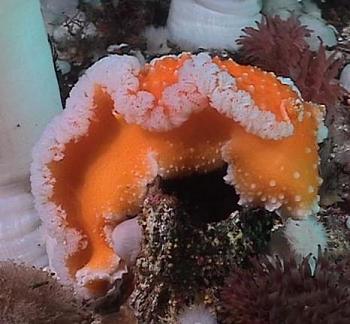
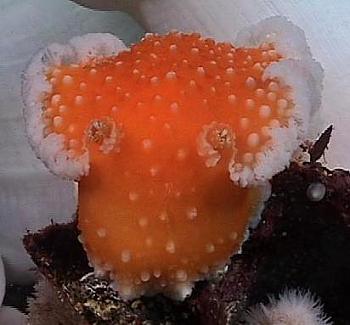
Tochuina tetraquetra
(Pallas, 1788)
Order: NUDIBRANCHIA
Suborder: DENDRONOTINA
Family: Tritoniidae
DISTRIBUTION
North Pacific from Northern Japan, Kuril Islands (Russia), Alaska, Canada, and south to California.
PHOTO
British Columbia, Canada, September 2000. "especially plentiful in the Port Hardy region (North end of the island). Depth ranged from 30-80 feet and all of the ones I saw were quite large; 150-200mm". Photo: Clinton Bauder.
One of the largest nudibranchs, growing to about 300mm long. Feeds on octocorals, including sea pens, gorgonians and softcorals. Ranges in colour from a pale yellow orange to a deep reddish orange, with whitish tipped tubercles all over the mantle. The small numerous branched gills form a white tufted fringe around the edge of the mantle.
Behrens reports that it is eaten both raw and cooked in the Kuril Islands where it is known as 'tochni'.
Reference:
• MacFarland, F. M. (1966) Studies of opisthobranchiate mollusks of the Pacific coast of North America. Memoirs of the California Academy of Sciences, 6: 1-546, pls. 1-72.
• Pallas, P.S. (1788). Marina varia nova et rariora. Nova Acta Acad. Sci. Imp. Petrop. 2: 229-250.
Rudman, W.B., 2000 (October 22) Tochuina tetraquetra (Pallas, 1788). [In] Sea Slug Forum. Australian Museum, Sydney. Available from http://www.seaslugforum.net/find/tochtetr
Related messages
Tochuina tetraquetra eggs
May 17, 2010
From: Jackie Hildering & Glen Miller
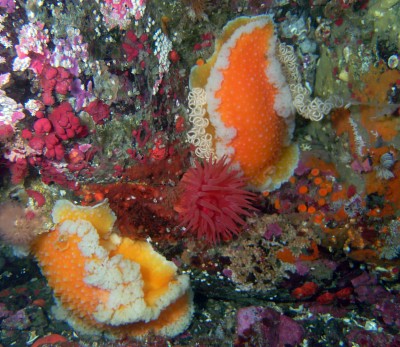
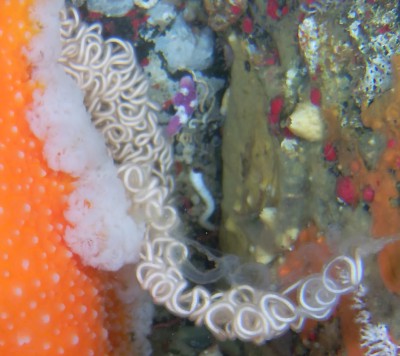
To follow up on our message of March 28th, 2007 [#19769], we've finally come across egg laying in Tochuina tetraquetra.
Locality: Telegraph Cove, 58 feet, BC, Canada, Pacific Ocean, 06 February 2010, Wall . Length: 15 inches. Photographer: Jackie Hildering and Glen Miller.
Jackie Hildering and Glen Miller
earthlingenterprises@telus.net
Hildering, J. & Miller, G., 2010 (May 17) Tochuina tetraquetra eggs. [Message in] Sea Slug Forum. Australian Museum, Sydney. Available from http://www.seaslugforum.net/find/23215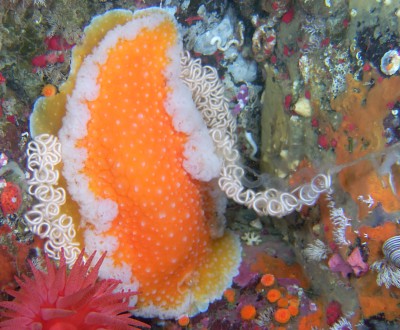
Dear Jackie and Glen,
Thanks! Patience is definitely a virtue when studying nudibranchs.
Best wishes,
Bill Rudman
Tochuina tetraquetra and egg mass
April 22, 2010
From: Jan Kocian
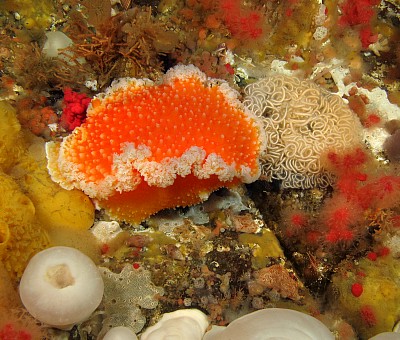
Couple more pictures of the Tochuina tetraquetra with egg mass. We found this large slug on almost every dive in the Browning Pass area.
Locality: Seven Tree Island, Browning Pass, Nigei Island, 65 feet, British Columbia, Canada, Eastern Pacific Ocean, 28 March 2010, wall. Length: 140 mm. Photographer: Jan Kocian.
Jan Kocian.
honkoc@hotmail.com
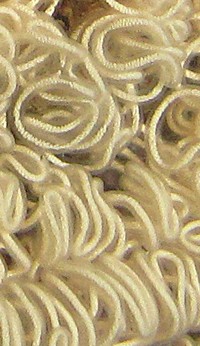
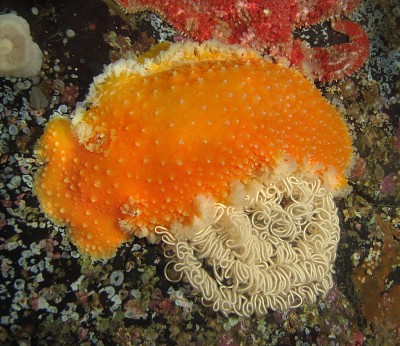
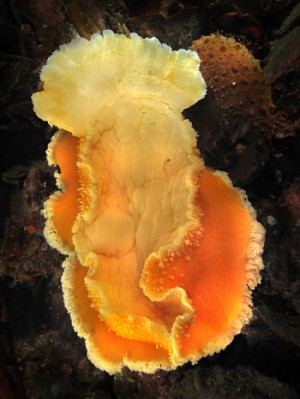
Thanks Jan,
Best wishes,
Bill Rudman
Tochuina tetraquetra in British Columbia - feeding
April 22, 2010
From: Jan Kocian
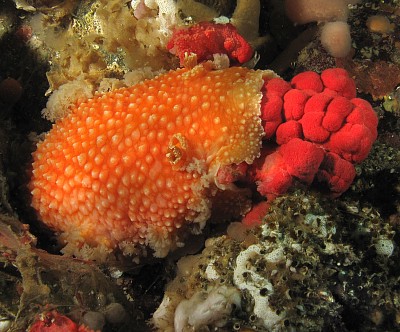
I finally made it to the Browning Pass famous for beautiful underwater scenery and I was not disappointed. The Tochuina tetraquetra fit right in with the other colorful marine life covering every inch of the vertical wall. Abundance of the Red Soft Coral (Gersemia rubiformis) seems to be one of the reasons the Tochuina is rather common sight here.
Locality: Browning Pass, Nigei Island, 60 feet, British Columbia, Canada, Eastern Pacific Ocean, March 28, 2010, wall. Length: 140 mm. Photographer: Jan Kocian.
Jan Kocian
honkoc@hotmail.com


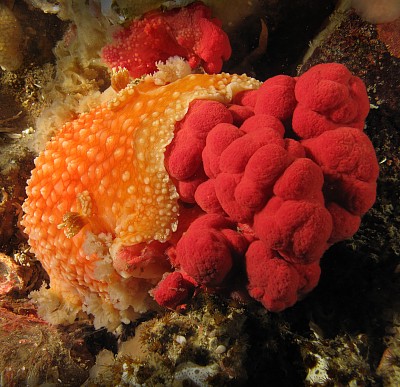
Dear Jan,
Thanks for these colourful photos. As you suggest, the presence of favourite food items is one of the main reasons nudibranchs are found at particular places. This soft coral is certainly reported to be one of the main food items of Tochuina
Best wishes,
Bill Rudman
Tochuina tetraquetra eggs
March 28, 2007
From: Jackie Hildering
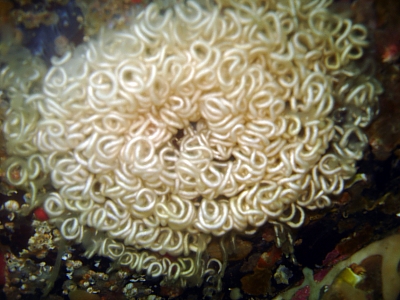
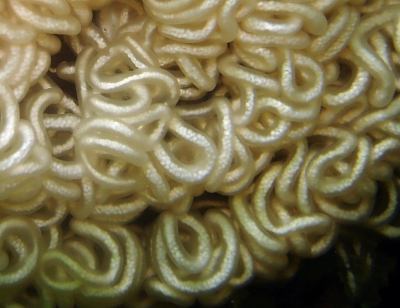
In our continuing quest to match our area's nudibranchs with their egg mass, we have now made enough observations of these egg masses and the nudibranchs close by them to be sure that these are from Tochuina tetraquetra.
Images are not as sharp as I would have liked but hope they are of help anyway.
Locality: Browning Wall, 45', British Columbia, Canada, Pacific Ocean, 24 March 2007, Wall . Length: Monsters! [Slug length] approx 17 inches. Photographer: Jackie Hildering.
Very best wishes,
Jackie
earthlingenterprises@telus.net
Hildering, Jackie, 2007 (Mar 28) Tochuina tetraquetra eggs. [Message in] Sea Slug Forum. Australian Museum, Sydney. Available from http://www.seaslugforum.net/find/19769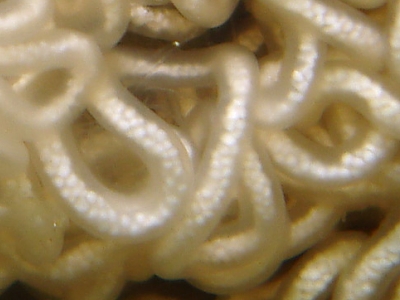
Hi Jackie,
Yes, I think I can confirm these as those of Tochuina, and very characteristic of the members of Dendronotina. They display a very characteristic ziz-zag folding of a long tangled string, laid in a coil. You will also note the the egg capsules themselves form a continuous coilded string about 4-5 eggs wide surrounded by a gelatin sheath approximately 1-2 eggs wide.
Thanks for sharing this,
Dave Behrens
Tochuina tetraquetra eating speed
May 26, 2006
From: Beto Nava
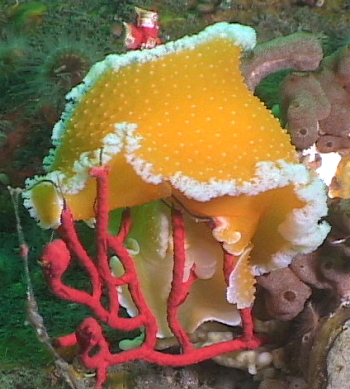
We found this specimen of Tochuina tetraquetra in Carmel, California in about 140ft of water. The animal was climbing on top of the red gorgonian, and most likely eating it.
I saw another gorgonia a couple of feet way similar to the one the animal is on, and it was completely destroyed .
I'm wondering how fast can they eat a gorgonian. Any idea?
This animal is in an area we know very well so I'm thinking about counting the good/damaged gorgonians in a 30 x 30 ft area and see what we get. We could repeat this several times in the next month as get an idea of how much does it eat. I hope it does not kill all the gorgonians in that area.
Locality: Point Lobos , 140ft, CA, USA, Ocean, 15 May 2006. Length: 4 inches. Photographer: Beto Nava.
Beto Nava
betonava@earthlink.net
Nava, A.E., 2006 (May 26) Tochuina tetraquetra eating speed. [Message in] Sea Slug Forum. Australian Museum, Sydney. Available from http://www.seaslugforum.net/find/16659Dear Beto,
I t certainly would be interesting to keep a record of how much it eats. One problem will be knowing whether there is anything else which may be eating the gorgonians at the same time - perhaps a fish or burrowing animal you may not see. I am not sure if anyone has studied feeding behaviour in Tochuina, but from the size of the animal in your photo, that gorgonian may be just a snack.
Best wishes,
Bill Rudman
Tochuina tetraquetra from British Columbia
October 24, 2003
From: Bruce Wight
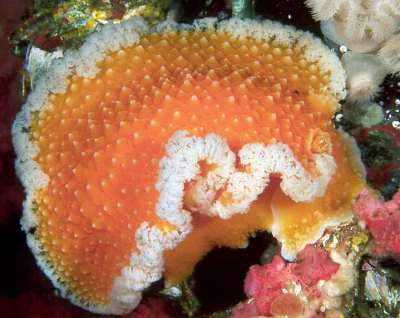
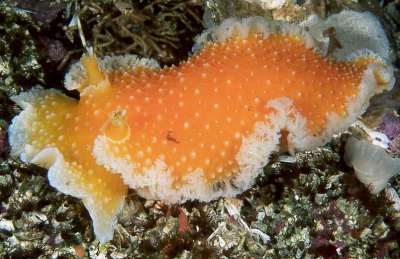
Dear Bill
Here are some photos of Tochuina tetraquetra from our recent trip to British Columbia.
Johanna and I were up at the Northern end of Vancouver Island the first week of October diving around Port Hardy and Browning Pass, British Columbia. This was our first time diving in Canada.
The Tochuina tetraquetra were large animals over 6 inches in length and common around the Gersemia pink soft corals, which we were told they feed on. These animals could handle the strong tidal currents where the Gersemia thrived. We also photographed Tritonia festiva which appeared to be feeding on the Gersemia [see separate message].
Take care,
Bruce Wight
bwproductions@earthlink.net
Wight, B., 2003 (Oct 24) Tochuina tetraquetra from British Columbia. [Message in] Sea Slug Forum. Australian Museum, Sydney. Available from http://www.seaslugforum.net/find/11284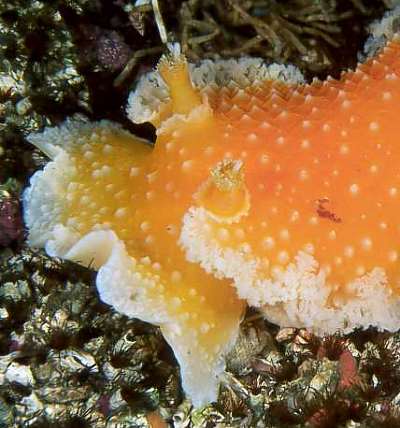
Thanks Bruce,
The one in your top photo seems to be taking an interest in the pink soft coral. Your photos really give us a 'feel' for these animals - not quite the same as 'being there' but a good second best
Best wishes
Bill Rudman
Tochuina tetraquetra feeding on gorgonian
February 5, 2003
From: Clinton Bauder
Hi Bill,
I did a deep dive with some friends on Sunday [2 February 2002] just north of the Mile Buoy in Monterey Bay, California. The depth there is about 38-48m. At a depth of about 44m we found a Tochuina tetraquetra apparently eating a Red Gorgonian (Lophogorgia chilensis). To my (limited) knowledge this hasn't been documented before though this animal is known to eat other octocorals. The animal was between 180 and 200mm long.
Clinton
gecko1@apple.com
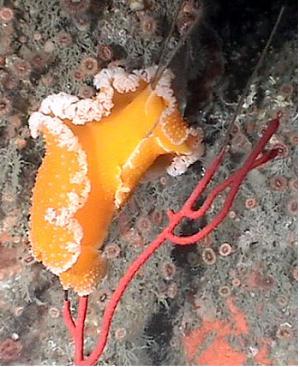
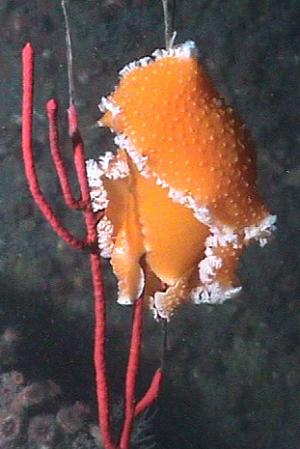
Thanks Clinton,
An interesting observation. It seems to be stripping the colony bare. I guess the water gives it sufficient bouyancy to crawl over the gorgonian without breaking or even bending its slender branches.
I checked in McDonald & Nybakken's List of the Worldwide Food Habits of Nudibranchs, and they list records of Tochuina feeding on a range of octocorals including the gorgonian Euplexaura marki, the nephtheid soft-coral Gersemia rubiformis, and Sea Pen Ptilosarcus gurneyi, which suggests a much broader diet than some other tritoniids. All these octocorals have very nasty chemical compounds in their bodies. With such a diet I don't know how Kuril Islanders can eat Tochuina raw or cooked. Perhaps its like a hot chili eating contest!
Best wishes,
Bill Rudman
Photos of Tochuina tetraquetra
October 25, 2000
From: Clinton Bauder


Hi Bill,
Here are some better images of Tochuina tetraquetra (which don't have a fish superimposed over the top!)
We saw lots of them in British Columbia, Canada, September 2000. They were especially plentiful in the Port Hardy region (North end of the island). Depth ranged from 30-80 feet and all of the ones I saw were quite large; 150-200mm.
Clinton
gecko1@apple.com
Bauder, C., 2000 (Oct 25) Photos of Tochuina tetraquetra. [Message in] Sea Slug Forum. Australian Museum, Sydney. Available from http://www.seaslugforum.net/find/3234Thanks Clinton,
Since I thought I had better identify the reddish animal alongside your photo of Anisodoris lentiginosa before it got entangled in the sea lemon debate, your photo of Tochuina was better than none. But I much prefer your replacements.
Best wishes,
Bill Rudman
